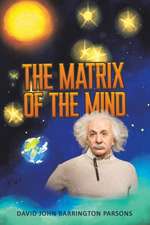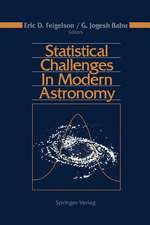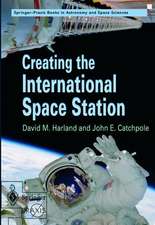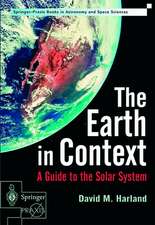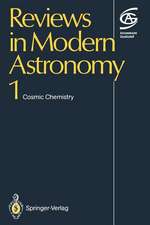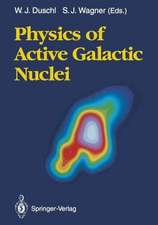Robotic Exploration of the Solar System: Part I: The Golden Age 1957-1982: Springer Praxis Books
Autor Paolo Ulivi, David M. Harlanden Limba Engleză Paperback – 23 oct 2007
| Toate formatele și edițiile | Preț | Express |
|---|---|---|
| Paperback (4) | 310.99 lei 3-5 săpt. | |
| Springer – 25 noi 2008 | 310.99 lei 3-5 săpt. | |
| Springer – 23 oct 2007 | 366.83 lei 3-5 săpt. | |
| Springer – 16 sep 2014 | 376.69 lei 6-8 săpt. | |
| Springer – 14 aug 2012 | 407.10 lei 38-44 zile |
Din seria Springer Praxis Books
-
 Preț: 294.46 lei
Preț: 294.46 lei -
 Preț: 223.45 lei
Preț: 223.45 lei -
 Preț: 193.12 lei
Preț: 193.12 lei -
 Preț: 167.85 lei
Preț: 167.85 lei -
 Preț: 288.98 lei
Preț: 288.98 lei -
 Preț: 323.74 lei
Preț: 323.74 lei -
 Preț: 401.38 lei
Preț: 401.38 lei -
 Preț: 264.12 lei
Preț: 264.12 lei - 8%
 Preț: 513.00 lei
Preț: 513.00 lei -
 Preț: 190.01 lei
Preț: 190.01 lei -
 Preț: 218.16 lei
Preț: 218.16 lei -
 Preț: 312.06 lei
Preț: 312.06 lei - 17%
 Preț: 414.05 lei
Preț: 414.05 lei -
 Preț: 216.41 lei
Preț: 216.41 lei -
 Preț: 262.27 lei
Preț: 262.27 lei -
 Preț: 264.35 lei
Preț: 264.35 lei -
 Preț: 167.63 lei
Preț: 167.63 lei -
 Preț: 284.81 lei
Preț: 284.81 lei -
 Preț: 259.08 lei
Preț: 259.08 lei -
 Preț: 305.47 lei
Preț: 305.47 lei -
 Preț: 244.14 lei
Preț: 244.14 lei -
 Preț: 227.85 lei
Preț: 227.85 lei -
 Preț: 285.25 lei
Preț: 285.25 lei -
 Preț: 295.56 lei
Preț: 295.56 lei -
 Preț: 357.17 lei
Preț: 357.17 lei -
 Preț: 275.79 lei
Preț: 275.79 lei -
 Preț: 257.08 lei
Preț: 257.08 lei -
 Preț: 349.71 lei
Preț: 349.71 lei -
 Preț: 272.45 lei
Preț: 272.45 lei -
 Preț: 270.27 lei
Preț: 270.27 lei - 8%
 Preț: 456.51 lei
Preț: 456.51 lei -
 Preț: 352.34 lei
Preț: 352.34 lei - 8%
 Preț: 394.80 lei
Preț: 394.80 lei -
 Preț: 320.65 lei
Preț: 320.65 lei -
 Preț: 325.29 lei
Preț: 325.29 lei -
 Preț: 253.11 lei
Preț: 253.11 lei -
 Preț: 192.86 lei
Preț: 192.86 lei -
 Preț: 313.40 lei
Preț: 313.40 lei -
 Preț: 150.51 lei
Preț: 150.51 lei -
 Preț: 233.34 lei
Preț: 233.34 lei -
 Preț: 286.78 lei
Preț: 286.78 lei -
 Preț: 212.01 lei
Preț: 212.01 lei -
 Preț: 299.99 lei
Preț: 299.99 lei -
 Preț: 232.27 lei
Preț: 232.27 lei -
 Preț: 284.58 lei
Preț: 284.58 lei -
 Preț: 212.45 lei
Preț: 212.45 lei -
 Preț: 159.81 lei
Preț: 159.81 lei -
 Preț: 349.48 lei
Preț: 349.48 lei - 20%
 Preț: 2061.64 lei
Preț: 2061.64 lei
Preț: 366.83 lei
Nou
Puncte Express: 550
Preț estimativ în valută:
70.20€ • 76.23$ • 58.97£
70.20€ • 76.23$ • 58.97£
Carte disponibilă
Livrare economică 01-15 aprilie
Preluare comenzi: 021 569.72.76
Specificații
ISBN-13: 9780387493268
ISBN-10: 0387493263
Pagini: 534
Ilustrații: LX, 536 p.
Dimensiuni: 174 x 244 x 31 mm
Greutate: 1.2 kg
Ediția:2007
Editura: Springer
Colecția Praxis
Seria Springer Praxis Books
Locul publicării:New York, NY, United States
ISBN-10: 0387493263
Pagini: 534
Ilustrații: LX, 536 p.
Dimensiuni: 174 x 244 x 31 mm
Greutate: 1.2 kg
Ediția:2007
Editura: Springer
Colecția Praxis
Seria Springer Praxis Books
Locul publicării:New York, NY, United States
Public țintă
Popular/generalCuprins
Introduction.- The beginning.- Of landers and orbiters.- The grandest tour.- Acronyms.- Glossary.- Appendices.- Chapter references.- Further reading.- Index.
Recenzii
From the reviews:
"This book … presents the accomplishments of robotic exploration of the major planets and their moons from Mercury to Neptune. Ulivi and Harland do a splendid job describing observations made using these … ‘robots’ to take pictures and explore the infrared and radio emissions, aurora, magnetic fields, and magnetospheres of these planets, their satellites, and the interplanetary medium. … More than 46 pages of references, further readings, excellent photographs and extensive illustrations, full author list, 6-page glossary, and 10-page index. Summing Up: Recommended. All levels." (W. E. Howard, CHOICE, Vol. 45 (8), 2008)
"Robotic Exploration of the Solar System would address events that had happened over the period from 1957 up to the present day. … this is a fantastic book – there is much in it that I, as a devotee of the subject for longer than either of the authors, can draw from it. It really is encyclopaedic in its coverage and is a wonderful work for old timers … and for students, new to the field, to consult to get up to speed." (Colin Pillinger, The Observatory, Vol. 128 (1203), 2008)
"The best book I read so far on space exploration. ...The combination of Harland the historian, and Ulivi the astronomer ... make this an outstanding contribution. First, this book describes the state of the knowledge of the solar system just before space exploration begins. Second, this book is comprehensive, in that it includes US, European and Soviet/Russian contributions. ... An excellent basis for those who are looking for a global view of this part of the history of science." (Patrick Haubrechts, amazon.com)
"This book … presents the accomplishments of robotic exploration of the major planets and their moons from Mercury to Neptune. Ulivi and Harland do a splendid job describing observations made using these … ‘robots’ to take pictures and explore the infrared and radio emissions, aurora, magnetic fields, and magnetospheres of these planets, their satellites, and the interplanetary medium. … More than 46 pages of references, further readings, excellent photographs and extensive illustrations, full author list, 6-page glossary, and 10-page index. Summing Up: Recommended. All levels." (W. E. Howard, CHOICE, Vol. 45 (8), 2008)
"Robotic Exploration of the Solar System would address events that had happened over the period from 1957 up to the present day. … this is a fantastic book – there is much in it that I, as a devotee of the subject for longer than either of the authors, can draw from it. It really is encyclopaedic in its coverage and is a wonderful work for old timers … and for students, new to the field, to consult to get up to speed." (Colin Pillinger, The Observatory, Vol. 128 (1203), 2008)
"The best book I read so far on space exploration. ...The combination of Harland the historian, and Ulivi the astronomer ... make this an outstanding contribution. First, this book describes the state of the knowledge of the solar system just before space exploration begins. Second, this book is comprehensive, in that it includes US, European and Soviet/Russian contributions. ... An excellent basis for those who are looking for a global view of this part of the history of science." (Patrick Haubrechts, amazon.com)
Notă biografică
The Second World War left among its many and painful heritages a new technology, ballistic missiles, that was to change the world, providing a way to carry into space instruments, satellites and probes that revolutionized science and technology.
Prior to launching artificial satellites, both the then Soviet Union and the United States developed more powerful intercontinental missiles with a range of thousands of miles. In the 1950s, the Soviets designed the huge 8K71 "Semiorka" (little seven, after the military designator R 7), a single staged rocket equipped with four large boosters and able to carry an heavy thermonuclear warhead to the continental US. In the USA, competition between the different armed forces prevailed, and the Army developed the medium range Redstone and Jupiter missiles, whilst the Air Force developed the Thor and two different ICBMs, Atlas and Titan and the Navy developed the Polaris submarine launched missiles.
The potential of all of these rockets to boost spacecraft were huge, but while in the Soviet Union it was decided to modify an 8K71 to carry a scientific payload into space, the United States decided that the Navy would develop a tiny new rocket called Vanguard, specifically designed for the task. This decision was to have grave repercussions: on 4 October 1957 the Soviet Union launched its PS-1 satellite, better known as Sputnik, which rocked the USA. This was compounded a month later by the launch of the PS-2, carrying the dog Laika. Following the explosion of the first Vanguard on December 6, the US Army then had the task to restore the American confidence by successfully carrying Explorer 1 into space on 1 February 1958 using the modified Redstone rocket called Juno 1. During the same year, the superpowers started working on new versions of their missiles able to carry small payloads to the Moon and, potentially, to the near planets. The space race had begun.
Prior to launching artificial satellites, both the then Soviet Union and the United States developed more powerful intercontinental missiles with a range of thousands of miles. In the 1950s, the Soviets designed the huge 8K71 "Semiorka" (little seven, after the military designator R 7), a single staged rocket equipped with four large boosters and able to carry an heavy thermonuclear warhead to the continental US. In the USA, competition between the different armed forces prevailed, and the Army developed the medium range Redstone and Jupiter missiles, whilst the Air Force developed the Thor and two different ICBMs, Atlas and Titan and the Navy developed the Polaris submarine launched missiles.
The potential of all of these rockets to boost spacecraft were huge, but while in the Soviet Union it was decided to modify an 8K71 to carry a scientific payload into space, the United States decided that the Navy would develop a tiny new rocket called Vanguard, specifically designed for the task. This decision was to have grave repercussions: on 4 October 1957 the Soviet Union launched its PS-1 satellite, better known as Sputnik, which rocked the USA. This was compounded a month later by the launch of the PS-2, carrying the dog Laika. Following the explosion of the first Vanguard on December 6, the US Army then had the task to restore the American confidence by successfully carrying Explorer 1 into space on 1 February 1958 using the modified Redstone rocket called Juno 1. During the same year, the superpowers started working on new versions of their missiles able to carry small payloads to the Moon and, potentially, to the near planets. The space race had begun.
Caracteristici
The 3-volume series will provide comprehensive coverage with thousands of references to the professional literature that should make it the 'first port of call' for people seeking information on the topic Emphasises the technology of space probes Comprehensive coverage ranges from the earliest planetary probes to the most recent planetary flights and missions Provides multilingual references (including Chinese, Russian, Czech, French, Italian) Details many unflown and unfulfilled missions, which may still be proven and useful in the future Describes the technical rivalry between the US and Soviet Union in the development of launchers
Textul de pe ultima copertă
In Robotic Exploration of the Solar System, Paolo Ulivi and David Harland provide a comprehensive account of the design and management of deep-space missions, the spacecraft involved – some flown, others not – their instruments, and their scientific results.
This fourth volume in the series covers the period 2004 to the present day and features:
- coverage of the Rosetta and Curiosity missions up to the end of 2013
- coverage of Mars missions since 2005, including the Mars Reconnaissance Orbiter, Phoenix and Fobos-Grunt, plus a description of plans for future robotic exploration of the Red Planet
- coverage of all planetary missions launched between 2004 and 2013, including the Deep Impact cometary mission, the MESSENGER Mercury orbiter, the New Horizons Pluto flyby and the Juno Jupiter orbiter
- the first complete description of the Chinese Chang’e 2 asteroid flyby mission ever published
- extensive coverage of future missions, including the European BepiColombo Mercury orbiter and international plans to revisit the most interesting moons of Jupiter and Saturn.
Descriere
Descriere de la o altă ediție sau format:
In Robotic Exploration of the Solar System, Paolo Ulivi and David Harland provide a comprehensive account of the design and management of deep-space missions, the spacecraft involved – some flown, others not – their instruments, and their scientific results.
This fourth volume in the series covers the period 2004 to the present day and features:
- coverage of the Rosetta and Curiosity missions up to the end of 2013
- coverage of Mars missions since 2005, including the Mars Reconnaissance Orbiter, Phoenix and Fobos-Grunt, plus a description of plans for future robotic exploration of the Red Planet
- coverage of all planetary missions launched between 2004 and 2013, including the Deep Impact cometary mission, the MESSENGER Mercury orbiter, the New Horizons Pluto flyby and the Juno Jupiter orbiter
- the first complete description of the Chinese Chang’e 2 asteroid flyby mission ever published
- extensive coverage of future missions, including the European BepiColombo Mercury orbiter and international plans to revisit the most interesting moons of Jupiter and Saturn.




